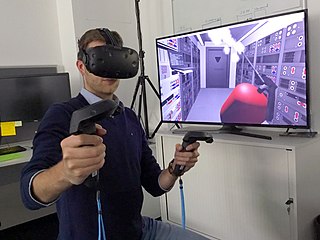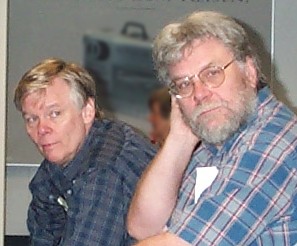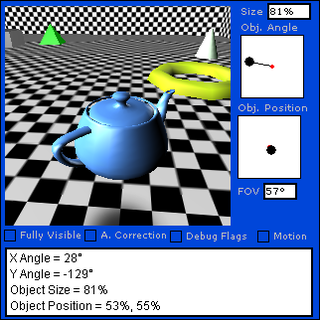Related Research Articles

Virtual reality (VR) is a simulated experience that can be similar to or completely different from the real world. Applications of virtual reality include entertainment, education and business. Other distinct types of VR-style technology include augmented reality and mixed reality, sometimes referred to as extended reality or XR, although definitions are currently changing due to the nascence of the industry.

Augmented reality (AR) is an interactive experience of a real-world environment where the objects that reside in the real world are enhanced by computer-generated perceptual information, sometimes across multiple sensory modalities, including visual, auditory, haptic, somatosensory and olfactory. AR can be defined as a system that incorporates three basic features: a combination of real and virtual worlds, real-time interaction, and accurate 3D registration of virtual and real objects. The overlaid sensory information can be constructive, or destructive. This experience is seamlessly interwoven with the physical world such that it is perceived as an immersive aspect of the real environment. In this way, augmented reality alters one's ongoing perception of a real-world environment, whereas virtual reality completely replaces the user's real-world environment with a simulated one.
Telepresence refers to a set of technologies which allow a person to feel as if they were present, to give the appearance or effect of being present via telerobotics, at a place other than their true location.
Artificial reality is a book series by Myron W. Krueger about interactive immersive environments, based on video recognition techniques, that put a user in full, unencumbered contact with the digital world. He started this work in the late 1960s and is considered to be a key figure in the early innovation of virtual reality. For 16 years Krueger was creating a computer system that connected the actions of a user to the real-time response of visual and auditory displays. Artificial Reality was published in 1983 and updated in Artificial Reality II in 1991. Artificial Reality II was to explore the concept of 'Videoplace', which is when a users body is implemented into a computer created world full of color, sound, and visuals. Whilst the first iteration of the series Artificial Reality has laid the ground work for different branches of computer-generated worlds like Virtual Reality and Augmented Reality. Visualization is key for all artificial realities to efficiently use data; resulting in being able to utilize human sensory systems that create these artificial realities.

Myron Krueger is an American computer artist who developed early interactive works. He is also considered to be one of the first generation virtual reality and augmented reality researchers.

A wired glove is an input device for human–computer interaction worn like a glove.
The Sword of Damocles was the name for the mechanical tracking system and not the head-mounted display, and is widely considered to be the first augmented reality HMD system, although Morton Heilig had already created a similar apparatus earlier, patented in 1960. The Sword of Damocles was created in 1968 by computer scientist Ivan Sutherland with the help of his students Bob Sproull, Quintin Foster, and Danny Cohen. Before he began working toward what he termed "the ultimate display", Ivan Sutherland was already well respected for his accomplishments in computer graphics. At MIT's Lincoln Laboratory beginning in 1966, Sutherland and his colleagues performed what are widely believed to be the first experiments with head-mounted displays of different kinds.

The Sensorama was a machine that is one of the earliest known examples of immersive, multi-sensory technology. This technology, which was introduced in 1962 by Morton Heilig, is considered one of the earliest virtual reality (VR) systems.
SIMNET was a wide area network with vehicle simulators and displays for real-time distributed combat simulation: tanks, helicopters and airplanes in a virtual battlefield. SIMNET was developed for and used by the United States military. SIMNET development began in the mid-1980s, was fielded starting in 1987, and was used for training until successor programs came online well into the 1990s.
Thomas Albert "Tom" DeFanti is an American computer graphics researcher and pioneer. His work has ranged from early computer animation, to scientific visualization, virtual reality, and grid computing. He is a distinguished professor of Computer Science at the University of Illinois at Chicago, and a research scientist at the California Institute for Telecommunications and Information Technology (Calit2).
The Electronic Visualization Laboratory (EVL) is an interdisciplinary research lab and graduate studies program at the University of Illinois at Chicago, bringing together faculty, students and staff primarily from the Art and Computer Science departments of UIC. The primary areas of research are in computer graphics, visualization, virtual and augmented reality, advanced networking, and media art. Graduates of EVL either earn a Masters or Doctoral degree in Computer Science.

Immersion into virtual reality (VR) is a perception of being physically present in a non-physical world. The perception is created by surrounding the user of the VR system in images, sound or other stimuli that provide an engrossing total environment.
Presence is a theoretical concept describing the extent to which media represent the world. Presence is further described by Matthew Lombard and Theresa Ditton as “an illusion that a mediated experience is not mediated." Today, it often considers the effect that people experience when they interact with a computer-mediated or computer-generated environment. The conceptualization of presence borrows from multiple fields including communication, computer science, psychology, science, engineering, philosophy, and the arts. The concept of presence accounts for a variety of computer applications and Web-based entertainment today that are developed on the fundamentals of the phenomenon, in order to give people the sense of, as Sheridan called it, “being there."
In computing, 3D interaction is a form of human-machine interaction where users are able to move and perform interaction in 3D space. Both human and machine process information where the physical position of elements in the 3D space is relevant.

In 3D video games, a virtual camera system aims at controlling a camera or a set of cameras to display a view of a 3D virtual world. Camera systems are used in video games where their purpose is to show the action at the best possible angle; more generally, they are used in 3D virtual worlds when a third-person view is required.
In computing, a natural user interface, or NUI, or natural interface is a user interface that is effectively invisible, and remains invisible as the user continuously learns increasingly complex interactions. The word "natural" is used because most computer interfaces use artificial control devices whose operation has to be learned. Examples include voice assistants, such as Alexa and Siri, touch and multitouch interactions on today's mobile phones and tablets, but also touch interfaces invisibly integrated into the textiles furnitures.
BeAnotherLab is an international anti-disciplinary collective dedicated to investigate the relationship between identity and empathy, attempting to communicate, understand and expand subjective experience through embodiment and telepresent experiences. The collective was born in Barcelona has collaborations with many individuals and institutions globally.

A virtual reality game or VR game is a video game played on virtual reality (VR) hardware. Most VR games are based on player immersion, typically through head-mounted display unit or headset and one or more controllers. The headset typically provides two stereoscopic displays in front of the user's eyes to simulate a 3D space.
Steven Mark Drucker is an American computer scientist who studies how to help people understand data, and communicate their insights to others. He is a Partner at Microsoft Research, where he also serves as the Research Manager of the VIDA group. Drucker is an affiliate professor at the University of Washington Computer Science and Engineering Department.
Cinematic virtual reality(Cine-VR) is an immersive experience where the audience can look around in 360 degrees while hearing spatialized audio specifically designed to reinforce the belief that the audience is actually in the virtual environment rather than watching it on a two-dimensional screen. Cine-VR is different from traditional Virtual Reality which uses computer generated worlds and characters more akin to interactive gaming engines, while cine-VR uses live images captured thorough a camera which makes it more like film.
References
- Kalawsky, R. S. (1993). The science of virtual reality and virtual environments : a technical, scientific and engineering reference on virtual environments, Addison-Wesley, Wokingham, England ; Reading, Mass
- Rheingold, H. (1992). Virtual reality, Simon & Schuster, New York, N.Y.
- Sturman, D. J., and Zeltzer, D. (1994). “A Survey of Glove-based Input.” IEEE Computer Graphics and Applications, 14(1), 30